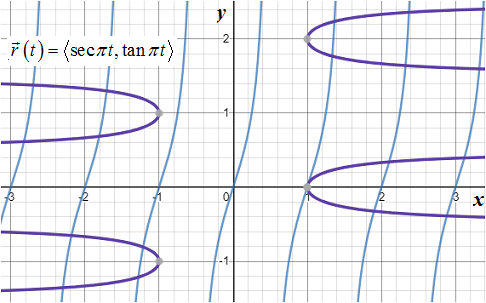
(a)
To calculate: The velocity and speed of the point at
(a)
Answer to Problem 46E
The required velocity and speed of the point are
Explanation of Solution
Given information:
The position of the particle:
Calculation:
The given position of the particle is
It is known that for a position
So,
Now,
At
Also, it is known that the magnitude of the velocity vector of a particle is known as the speed of the particle.
The magnitude of a vector
At
Hence, the required velocity and speed of the point are
(b)
To determine: The equation of the hyperbola in x and y by eliminating the parameter.
(b)
Answer to Problem 46E
The required equation is
Explanation of Solution
Given information:
The position of the point:
Calculation:
The given position of the point is
Use the
Write the expressions
Also,
Use subtraction on the above two equations:
Hence, the required equation is
(c)
To graph: The path of the particle over the time interval
(c)
Explanation of Solution
Given information:
The position of the point:
Calculation:
The given position of the point is
The required graph for the path of the particle is shown below:

Chapter 11 Solutions
Calculus 2012 Student Edition (by Finney/Demana/Waits/Kennedy)
Additional Math Textbook Solutions
Calculus: Early Transcendentals (3rd Edition)
Calculus and Its Applications (11th Edition)
Precalculus Enhanced with Graphing Utilities (7th Edition)
Precalculus: Concepts Through Functions, A Unit Circle Approach to Trigonometry (4th Edition)
University Calculus: Early Transcendentals (3rd Edition)
Single Variable Calculus: Early Transcendentals (2nd Edition) - Standalone book
 Calculus: Early TranscendentalsCalculusISBN:9781285741550Author:James StewartPublisher:Cengage Learning
Calculus: Early TranscendentalsCalculusISBN:9781285741550Author:James StewartPublisher:Cengage Learning Thomas' Calculus (14th Edition)CalculusISBN:9780134438986Author:Joel R. Hass, Christopher E. Heil, Maurice D. WeirPublisher:PEARSON
Thomas' Calculus (14th Edition)CalculusISBN:9780134438986Author:Joel R. Hass, Christopher E. Heil, Maurice D. WeirPublisher:PEARSON Calculus: Early Transcendentals (3rd Edition)CalculusISBN:9780134763644Author:William L. Briggs, Lyle Cochran, Bernard Gillett, Eric SchulzPublisher:PEARSON
Calculus: Early Transcendentals (3rd Edition)CalculusISBN:9780134763644Author:William L. Briggs, Lyle Cochran, Bernard Gillett, Eric SchulzPublisher:PEARSON Calculus: Early TranscendentalsCalculusISBN:9781319050740Author:Jon Rogawski, Colin Adams, Robert FranzosaPublisher:W. H. Freeman
Calculus: Early TranscendentalsCalculusISBN:9781319050740Author:Jon Rogawski, Colin Adams, Robert FranzosaPublisher:W. H. Freeman
 Calculus: Early Transcendental FunctionsCalculusISBN:9781337552516Author:Ron Larson, Bruce H. EdwardsPublisher:Cengage Learning
Calculus: Early Transcendental FunctionsCalculusISBN:9781337552516Author:Ron Larson, Bruce H. EdwardsPublisher:Cengage Learning





